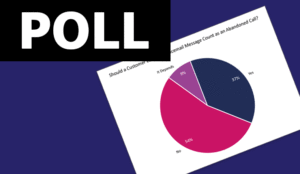Dick Bourke of Scorebuddy compares how voicemails and callbacks are used in the contact centre, before sharing his preference.
Customer experience executives in all types of businesses continually evaluate call centre activities to determine what methods work best for their company. And that’s not an easy task given the flood of emerging solutions to improve customer experiences.
Sorting through new methods to figure out how to improve customer experience in the call centre can be challenging and it can still be a trial-and-error proposition until a solution proves its worth.
Savvy call centre customer experience experts spend a lot of time consuming information about new technologies and engagement options to help improve call centre customer experience. Some of the shiny new solutions available include artificial intelligence, machine learning, speech analytics, live chat and social collaboration and engagement tools.
And while those all have merit in the right circumstances, sometimes call centre managers have to make decisions on basic functions such as using voicemail or callback methods for customer communications. They may seem outdated when compared to emerging technologies, but voicemail and callback have stood the test of time when it comes to customer communications. Smart call centre and QA managers know how to use them to their advantage and when to use other solutions when appropriate.
Moving Calls Through the Call Centre
Obviously, the goal of each call is to maximise customer satisfaction and CX as efficiently and effectively as possible. Any movement that puts a customer further away from a speedy resolution is a step that should be considered avoidable. However, in the real world, calls may slip past agents whose time is currently preoccupied with serving other customers.
There is a fine balance between moving calls through the centre and optimising agent time. New technologies have emerged to help facilitate waiting customers, but sometimes the number of incoming calls is more than the agents can handle at once, and call centre executives need to rely on two old standbys—voicemail and callbacks.
While agents might be helping resolve as many inbound call as they can, there may still be customers that are waiting to be served and are unable or unwilling to stay on hold until an agent becomes available. Adding voicemail-dedicated agents can be one solution, but does it work to provide a good customer experience?
Just moving calls around can’t be a viable solution unless you always have an agent available for every call (an infeasible goal that would also be extremely pricey). And you’ll run the risk of losing customers who need to talk to an agent and are denied that opportunity. Not every caller is willing to wait until they receive a callback, and if a customer has to call in multiple times just to reach a live person on the other line, the result is a very poor call centre customer experience.
Setting the Appropriate Tone for Customer Satisfaction
When implementing call centre call routing, it’s imperative to keep customers in mind at all times and design a plan that provides the best call centre customer experience. Managing customer experiences and perceptions occurs when setting the routing for customer calls to be handled via inbound agents, outbound agents or a blend of both.
When inbound agents are tasked with responding to voicemail messages, it is a very labour-intensive process that also takes the agents out of queue responding to live customer calls. Hiring outbound agents to manage only voicemail messages is costly and ineffective. If voicemail must be an option for customer responses, then it’s critical to use a mix of both inbound and outbound agents.
Customer Callback Improves Call Centre Customer Experience and Sends the Right Message
Many organisations could be better served by avoiding voicemail in their call centres, not only because they are tedious tasks for agents but also because of the negative perception voicemail sends to customers. No one wants to feel as if he or she isn’t important enough to rate a live call with a company agent.
Call centres should work as hard as possible to remove as much friction as possible from each customer interaction. Callbacks are great tools for improving perceptions when it comes to customer calls with agents. The very easy act of offering a callback instead of being sent to voicemail or staying on hold for an indefinite period of time may be the thing that radically boosts perceptions of a call centre.
A callback option keeps customers happy in high-traffic periods because they simply land into queue and can go about their lives without being tethered to a phone. Callbacks are great options for agents and customers and provide next-level CX for clients.
3 Ways That Callbacks Improve Your Call Centre
- Lifts customer satisfaction by eliminating “waiting on hold” or “being sent to voicemail”, which are some common customer complaints when interacting with the call centre.
- Reduces abandon rates because callers are more inclined to stay in the process if offered a callback as opposed to staying on hold or being sent to voicemail.
- Reduces expenses because phone lines aren’t kept open when callers are left on hold for a long time. Billing is more effective with callbacks when lines are engaged only when there is an available agent to complete the customer call.

Dick Bourke
Today’s customers are more demanding than ever and are more inclined to share their dissatisfaction with others on social media and on review sites. This type of customer dissatisfaction can have far-reaching impact but can be alleviated with the integration of callback options that will improve CX in the call centre.
Leaving a customer on hold for too long or sending them to voicemail can be the kiss of death for any engagement but can be avoided altogether when using a simple callback option for handling customer satisfaction.
Author: Robyn Coppell
Published On: 7th Mar 2019 - Last modified: 12th Mar 2019
Read more about - Guest Blogs, Scorebuddy
















